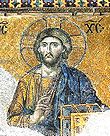Feast of the Holy Name of Jesus
The Feast of the Holy Name of Jesus has been celebrated in the Roman Catholic calendar of saints, at least at local levels, since the end of the fifteenth century. The veneration of the Holy Name was extended to the entire Roman Catholic Church on 20 December 1721, during the pontificate of Pope Innocent XIII.
The celebration has been held on different dates, usually in January, because 1 January, eight days after Christmas, commemorates the circumcision of the child Jesus; as recounted in the Gospel read on that day, "at the end of eight days, when he was circumcised, he was called Jesus, the name given by the angel before he was conceived in the womb."[1] Medieval Catholicism, and many other Christian churches to the present day, therefore celebrated both events as the Feast of the Circumcision of Christ, usually on 1 January. The famous preacher Saint Bernardino of Siena placed great emphasis on the Holy Name, which he associated with the IHS sign, and may be responsible for the coupling of the two elements.
It is observed on 3 January by Catholics following the present General Roman Calendar, and on the Sunday between the Octave of Christmas and Epiphany (or 2 January) by Catholics following calendars of the 1914-1969 period.
In the Lutheran Church, it is observed on 1 January[2]
Contents |
[edit] Veneration of the Holy Name
The veneration of the Holy Name was encouraged by the example of Bernard of Clairvaux, who apostrophized it in many sermons. But the greatest promoters of this devotion were Bernardino of Siena and his follower John Capistrano. "They carried with them on their missions in the turbulent cities of Italy a copy of the monogram of the Holy Name, surrounded by rays, painted on a wooden tablet, wherewith they blessed the sick and wrought great miracles. At the close of their sermons they exhibited this emblem to the faithful and asked them to prostrate themselves, to adore the Redeemer of mankind." The practice of showing the monogram of Jesus over gates and above doors largely begins with their exhortations, which had an unorthodox air that brought Bernardino before the tribunal of Pope Martin V. But John Capistrano defended his master so successfully that the pope not only permitted the veneration of the Holy Name, but also assisted at a procession in which the holy monogram was carried. The tablet used by St. Bernardino is venerated at the basilica of Santa Maria in Aracoeli at Rome.
[edit] Date of observance
Franciscans, Carmelites, and Augustinians kept the feast on 14 January; Dominicans on 15 January; in some localities the date was 8 January, in others 31 January, in some localities in Great Britain on 7 August. The date of the second Sunday after Epiphany was chosen by the Carthusians, then by Spain in general. This was the date assigned to the celebration when, in 1721, it was inserted into the General Calendar of the Roman Rite. In the reform of Pope Pius X, enacted by his motu proprio Abhinc duos annos of 23 October 1913, it was moved to the Sunday between 2 and 5 January inclusive; in years when no such Sunday existed the celebration was observed on 2 January. This is still kept by those traditionalist Catholics who accept the changes of Pope Pius X in 1913, but not those of Pope Paul VI in 1969.
The reform of the liturgical calendar by the motu proprio Mysterii Paschalis of 14 February 1969, removed the feast, "since the imposition of the name of Jesus is already commemorated in the office of the Octave of Christmas." However, the Mass texts of the Holy Name of Jesus were preserved, being placed with the Votive Masses.[3] The celebration was restored to the General Roman Calendar with the 2002 Roman Missal, assigned as an optional memorial to the first free day after 1 January, namely 3 January.
In some Anglican churches including the Episcopal Church in the United States of America and the Anglican Church of Canada, the feast is observed on 1 January. In the Church of England, the calendar of the 1662 Book of Common Prayer stipulates a festival "The Name of Jesus" to be observed on 7 August, but in the more recent Common Worship resources the Feast of the Circumcision of Christ (1 January) takes its place as the primary festival of the name of Jesus.
In the Lutheran Church, the Festival of the Holy Name of Jesus is celebrated on 1 January.
[edit] See also
[edit] References
- ^ Luke 2:21
- ^ Calendar of Saints (Lutheran)
- ^ See Variationes in Calendarium Romanum Inductae in Calendarium Romanum [Vatican Polyglot Press, 1969], page 115.

